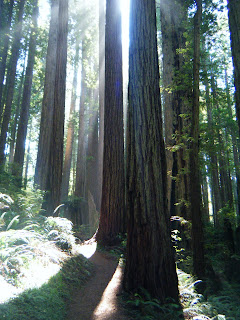Redwood National Park was absolutely enchanting.
On our first day at the park, about mid-morning, my father and I started out on Miner's Ridge Trail. After walking about 20 minutes, we'd passed many a moderately tall and rather skinny tree, all the while remarking to one another, “Hey this one is kinda big, maybe this one!” We had been pointed this direction by a friendly but not so convincingly knowledgeable visitor's assistant and were beginning to have our doubts if we were indeed in an "old growth" redwood forest. After all the young man had said, “You can't miss 'em!”
Good thing we kept on hiking because within minutes we rounded the bend and it was as if we'd walked through a time portal, suddenly standing amidst the forest of the dinosaurs. Towering redwoods with thick shreddy bark stood over 300 feet tall, many encircled by woody growths called "burls" at their base. Ferns waved in the light breeze, some so tall they grazed my armpits. The largest wood sorrel I've ever seen blanketed the forest floor, each of the three leaflets imprinted with what looked like a white fingerprint and upon turning them over, were painted a deep purple. Horesetail grew dense, like our familiar cat-tails, in the slow-flowing streams.
 |
| Redwood Sorrel (Oxalis oregana) - this sorrel is distinctive in its white veins and solitary pink flower. Edible like all the other Oxalis! |
 |
| Underside of Redwood Sorrel |
These old-growth redwood forests truly are the forests of the dinosaurs, or at least it is believed they are from what we know of that period, the Eocene era. The perpetual fog, shelter from the shoreline, year-round moderate temps, as well as generous precipitation (25 - 100" rainfall / yr) have allowed these forests to persist in their prehistoric state. The abundant horsetail, ferns, and mosses only support this theory as all these were the first plants on the ecological scene, reproducing by spores rather than flowers.
 |
| Unknown to me! Ferns are a whole new territory...any of my fern-loving readers know? |
 |
| Western Five-Finger Fern (Adiantum aleuticum) |
 |
| Western Sword Fern - so I think! |
My father and I camped on Gold Bluffs Beach and though the winds were a bit strong they were still rather mellow compared to the Outer Banks. The temps were chilly and the skies were mostly cloudy, further enhancing the mystery of this land. How novel it was to see folks walking about their camps and along the shore in hats, vests, and turtleneck sweaters. I bundled up, took off my shoes and let the choppy white waves wash over my feet, working the sand between my toes and inadvertently soaking my jeans rolled up to the knee. I had traveled from the shores of the Atlantic on the Outer Banks to the shores of the Pacific in Northern California. What a beautiful country we live in, one could explore it endlessly.
Speaking of sand...it was gray-black here, made up of finely ground ancient river and cliff rock. In place of shells, smooth stone of every color laid in piles at low tide. Using my Crocs like two small baskets, I filled them to the heels with these coastal gems. The rivers here flow north instead of south and I was told by a kindly inn-keeper this has much to do with all rock washed ashore.
 |
| Northern California coast |
Though on the other side of the country, in a land I'd never before visited, I felt a connection to this place. The lush vegetation of the dense forest offered a familiarity, whereas the treetops shrouded by clouds and the rocky cliffs overlooking a seemingly endless ocean seemed to veil my ever really “knowing” this place. These are traits offered by all wild places as well as those I try most to cultivate in my own daily existence: the known and the unknown. Here, the contrast was stark.
Oh, and I can't forget the surprisingly graceful creatures we saw on the second evening around dusk, one of which was bellowing out his manly mating call...hey ladies, get a load of these antlers!
 |
| Wild Elk |
Thank you Redwoods!


The unknown-to-you at the top of the ferns looks like an inside-out flower, also known more commonly as duckfoot (which I prefer to use as the flowers don't seem to be around as often as the leaves).
ReplyDelete